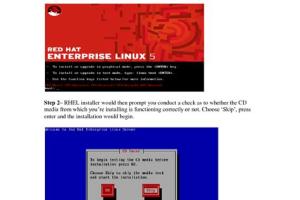Mastering Software Installation in Red Hat Linux: A Comprehensive Guide

-
Quick Links:
- Introduction
- Understanding Red Hat Linux
- Software Installation Methods
- Case Studies
- Common Issues and Solutions
- Best Practices for Software Installation
- FAQs
- Conclusion
Introduction
Installing software in Red Hat Linux can be a straightforward process once you understand the various methods available. This guide aims to provide a comprehensive overview of how to install software effectively in Red Hat Linux, exploring everything from RPM and DNF to YUM and compiling from source. Whether you are a novice or an experienced user, this article will equip you with the knowledge you need.
Understanding Red Hat Linux
Red Hat Linux is a popular open-source operating system known for its stability and strong community support. It is widely used in enterprise environments, making it essential for IT professionals to understand how to manage software installations.
Software Installation Methods
There are several methods to install software on Red Hat Linux. Each method has its own advantages and use cases. Below, we will explore these methods in detail.
Using RPM
The RPM Package Manager (RPM) is a powerful tool for managing software in Red Hat-based distributions. It allows users to install, remove, and manage software packages.
rpm -ivh package-name.rpmHere’s how to install a package using RPM:
- Download the RPM package from a trusted source.
- Open your terminal and navigate to the directory where the package is located.
- Use the command above to install the package.
Using DNF
DNF (Dandified YUM) is the next-generation version of YUM and is included in Red Hat 8 and above. It is designed to be more efficient and user-friendly.
dnf install package-nameTo install software using DNF:
- Open your terminal.
- Run the command as shown above to install your desired package.
Using YUM
YUM (Yellowdog Updater, Modified) is an older package manager that is still widely used in Red Hat 7 and earlier versions.
yum install package-nameTo install software using YUM:
- Access your terminal.
- Execute the YUM command to install the package.
Installing from Source Code
Sometimes, the software you want may not be available in binary format. In such cases, you can compile it from source.
./configure
make
make installFollow these steps to install software from source:
- Download the source code tarball from the official site.
- Extract it using the command:
tar -xvzf filename.tar.gz - Navigate to the extracted directory and run the commands above.
Case Studies
Understanding practical applications of software installation can provide deeper insights. Below are two case studies illustrating different scenarios.
Case Study 1: Installing a Web Server
A software engineer was tasked with setting up a web server for an internal application. Using DNF, he successfully installed the necessary packages with a few commands.
Case Study 2: Compiling Software from Source
A developer needed a specific version of a library that wasn't available in the repositories. By downloading the source code, he was able to compile it and integrate it into his project seamlessly.
Common Issues and Solutions
Software installation can sometimes lead to issues. Here are some common problems and their solutions:
- Dependency Errors: Use
dnf deplist package-nameto identify and install missing dependencies. - Package Not Found: Ensure your repositories are updated with
dnf update. - Permission Denied: Use
sudobefore your command to run it as an administrator.
Best Practices for Software Installation
To ensure a smooth software installation experience, consider the following best practices:
- Always install from trusted sources.
- Keep your system updated regularly.
- Use package managers for easier dependency management.
- Document your installation processes for future reference.
FAQs
1. What is the difference between RPM and DNF?
RPM is a low-level package manager, while DNF is a higher-level tool that manages dependencies and simplifies installations.
2. Can I uninstall software using DNF?
Yes, you can uninstall software by using the command: dnf remove package-name.
3. How do I check installed packages?
You can check installed packages with the command: dnf list installed.
4. What should I do if a package fails to install?
Check for dependency issues or ensure that your package manager is updated.
5. Can I use YUM on Red Hat 8?
While YUM can still be used, DNF is recommended for Red Hat 8 and above.
6. Is there a graphical interface for software management?
Yes, tools like GNOME Software provide a graphical interface for managing software.
7. How can I find more software packages?
You can search for packages using dnf search keyword.
8. What is a repository?
A repository is a storage location where software packages are stored and from which they can be retrieved and installed.
9. How do I add third-party repositories?
You can add a repository by creating a new `.repo` file under `/etc/yum.repos.d/`.
10. What is the best practice for managing software?
Use a combination of package managers, document installations, and regularly update your system to manage software effectively.
Conclusion
Installing software in Red Hat Linux can be a straightforward process with the right tools and knowledge. By understanding the various methods available and following best practices, you can manage your software installations effectively. This guide serves as a valuable resource for anyone looking to master software installation in Red Hat Linux.
Random Reads
- Remove widgets android phone
- Remove spaces excel
- How to remove linoleum
- How to remove mobile games on android
- How to check free hard disk space
- How to embed pictures
- How to embed sql query in excel
- How to remove clutter from your home
- How to remove drawers
- How to get hm fly pokemon heartgold soulsilver